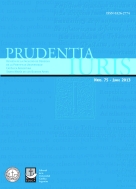Por favor, use este identificador para citar o enlazar este ítem:
https://repositorio.uca.edu.ar/handle/123456789/2766| Campo DC | Valor | Lengua/Idioma |
|---|---|---|
| dc.contributor.author | Bermúdez, Fernando Adrián | es |
| dc.date.accessioned | 2019-05-23T13:09:12Z | - |
| dc.date.available | 2019-05-23T13:09:12Z | - |
| dc.date.issued | 2013 | - |
| dc.identifier.citation | Bermúdez, F. A. El pensamiento filosófico-jurídico de Juan Alfredo Casaubón [en línea], Prudentia Iuris. 2013, 75. Disponible en: https://repositorio.uca.edu.ar/handle/123456789/2766 | es |
| dc.identifier.issn | 0326-2774 | - |
| dc.identifier.uri | https://repositorio.uca.edu.ar/handle/123456789/2766 | - |
| dc.description.abstract | Resumen: En el presente trabajo se estudia y analiza el pensamiento iusfilosófico de Juan Alfredo Casaubón, unos de los autores iusnaturalistas más significativo de la Argentina en el siglo XX. Heredero de la tradición clásica que conocerá en los famosos Cursos de Cultura Católica y, posteriormente, en la Pontificia Universidad Católica Santa María de los Buenos Aires, de la cual será uno de sus profesores fundadores. Abogado, docente, juez, investigador, padre y esposo. Su pensamiento, si bien se puede encuadrar en la Tradición Central de Occidente, tendrá diversas particularidades que le darán a su pensamiento una nueva impronta a la filosofía jurídica. Se ha tratado de sintetizar el pensamiento casaubiano en diez tesis principales que reflejan en su estricta medida todo el corpus de este filósofo argentino. Previo al desarrollo iusfilosófico del autor, se ha tratado de encuadrar su posición filosófica general y, luego, jurídica, a través de su concepción iusnaturalista. Por último, se hará un pequeño homenaje a este gran pensador en el marco de la filosofía argentina del siglo XX. | es |
| dc.description.abstract | Abstract: In this paper we study and analyze the jusphilosophical thought of Juan Alfredo Casaubón, one of the most significant authors of the natural law in the twentieth century Argentina. Heir to the classical tradition known in the famous Catholic culture courses and later, in the Santa Maria Catholic University of Buenos Aires, which is one of the founding teachers. Lawyer, teacher, judge, investigator, father and husband. His thought, although you can pan in the central tradition of the West, will have different characteristics that will give your mind a new mark with the legal philosophy. We have tried to synthesize the thought casaubiano in ten main thesis reflected in his strict as the entire corpus of this argentine philosopher. Prior to the development jusphilosophical the author has tried to frame their general philosophical position and then, its legal framework, through its conception of natural law. Finally, there will be a small tribute to this great thinker in the context of philosophy of the twentieth century argentina. | es |
| dc.format | application/pdf | es |
| dc.language.iso | spa | es |
| dc.publisher | EDUCA | es |
| dc.rights | Acceso Abierto | es |
| dc.rights.uri | https://creativecommons.org/licenses/by-nc-sa/4.0/ | es |
| dc.source | Prudentia Iuris, 75 | es |
| dc.source | ISSN 0326-2774 | es |
| dc.subject | Casaubón, Juan Alfredo, 1919-2010 | es |
| dc.subject | IUSNATURALISMO | es |
| dc.subject | JUSTICIA | es |
| dc.subject | DERECHO | es |
| dc.subject | FILOSOFIA DEL DERECHO | es |
| dc.title | El pensamiento filosófico-jurídico de Juan Alfredo Casaubón | es |
| dc.type | Artículo | es |
| uca.path | Prudentia Iuris|2013 nº 75 | es |
| uca.disciplina | DERECHO | es |
| uca.filename | /home/data-uca-generic/folder_generic/Revistas de la Universidad/prudentia/prudentia75/pensamiento-filosofico-juridico-casaubon/metadata.xml | es |
| uca.issnrd | 1 | es |
| uca.affiliation | Fil: Bermúdez, Fernando Adrián. Universidad Nacional de Cuyo; Argentina | es |
| uca.affiliation | Fil: Bermúdez, Fernando Adrián. Universidad de Mendoza; Argentina | es |
| uca.orden | 07 | es |
| uca.version | publishedVersion | es |
| item.fulltext | With Fulltext | - |
| item.grantfulltext | open | - |
| item.languageiso639-1 | es | - |
| Aparece en las colecciones: | PI - 2013 nro. 75 | |
Ficheros en este ítem:
| Fichero | Descripción | Tamaño | Formato | |
|---|---|---|---|---|
| pensamiento-filosofico-juridico-casaubon.pdf | 259,39 kB | Adobe PDF |  Visualizar/Abrir |
Visualizaciones de página(s)
1.224
comprobado en 30-abr-2024
Descarga(s)
1.733
comprobado en 30-abr-2024
Google ScholarTM
Ver en Google Scholar
Este ítem está sujeto a una Licencia Creative Commons

